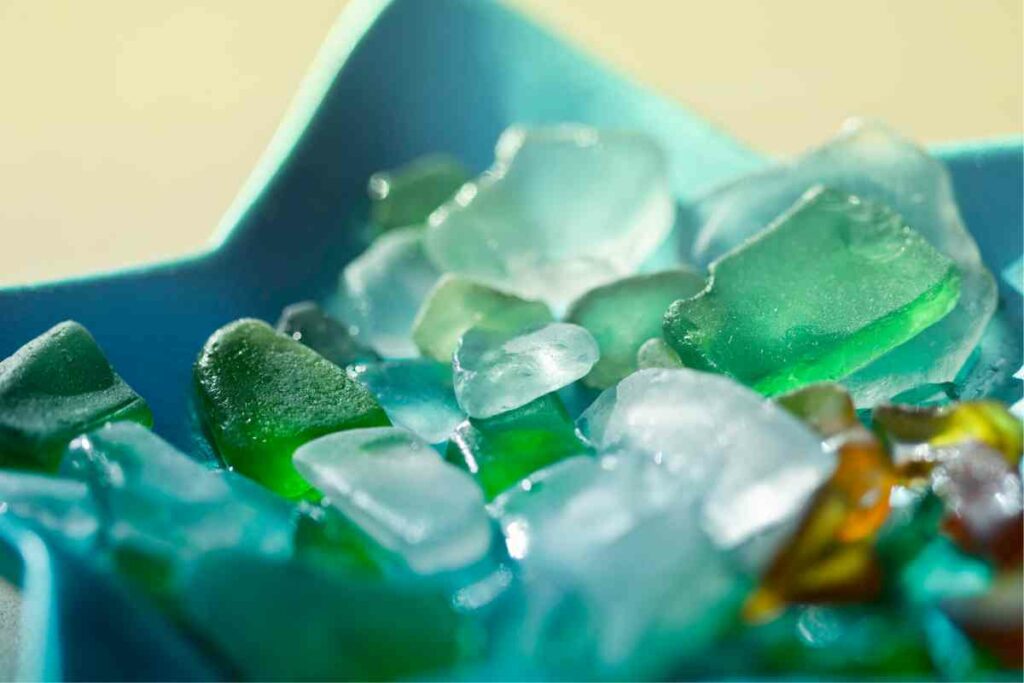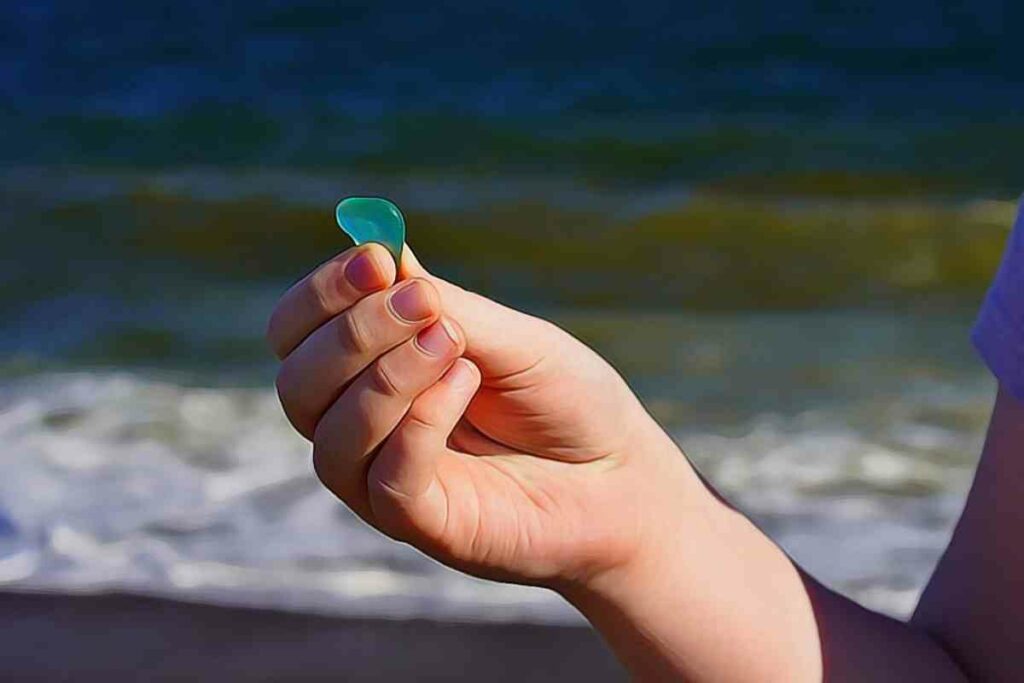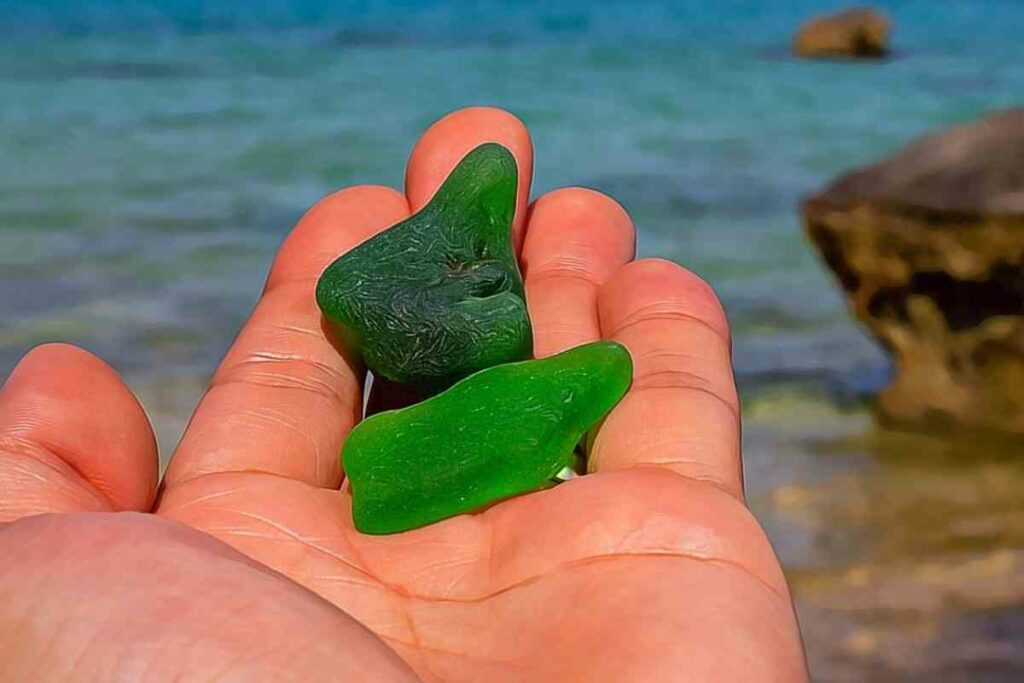Ordinarily, it takes anywhere from 10 to 100 years for glass to become sea glass, depending on ocean currents and tidal conditions.
The more extreme the conditions are, the faster the weathering process and, consequently, the transformation to sea glass.
How Long Does It Take For Glass To Become Sea Glass?
Sea glass, also known as sea gems, mermaid’s tears, or beach pearls, refers to any polished glass piece that a saltwater body has naturally weathered.
It will have a frosted surface and a rounded edge with tiny pores.

The sea acts as a large recycling facility, turning glass trash into a treasure over the course of 100 years.
The physical and chemical transformation process begins as soon as the glass pieces from dumpsites, beaches, or even shipwrecks make their way into the sea.
Over the next decade(s), ocean waves will tumble the glass over sand and rocks, battering its surface and breaking it down into smaller pieces. As the sand grains etch onto the glass’s surface, they further smoothen its sharp edges resulting in a flawless gem.
Prolonged exposure to the sun and saline water results in dissolving soda and lime additives from the glass, the commonly used additives in glass production.
It gives sea glass its distinctive frosty appearance with tinny little pores.

After years of tumbling at sea, waves wash the perfect, naturally polished glass pieces onto different sandy beaches around the world, where beachcombers and collectors wait anxiously.
How Do You Tell If Sea Glass Is Authentic?
Sea glasses come in many colors and sizes. White(transparent), green, and brown sea glasses are the majority.
Orange and red are the rarest glasses to be found. The scarcity and alluring appearance makes them very valuable and popular with antique collectors as well as jewelers.

This has led to artificial manufacturing to satisfy the ever-increasing demand. Despite best efforts, synthetic sea glasses cannot reach the flawless quality of natural ones.
To tell them apart, you need a keen eye, and these are some of the features you need to look out for:
- Smooth texture – authentic sea glass has tiny perforations yet remains super soft from tumbling in the sea, unlike artificial ones made in cement mixers and sanded.
- Frostier appearance – it is a unique feature of sea glass due to the chemical erosion of glass from the sun and ocean elements.
- Color – the color code determines the value of the glass. For example, red sea glass is super rare fetching premium bucks. Exercise caution if you find one retailing at the same brown piece.
- Asymmetrical shapes/sizes – sea glasses come out in various sizes, and it’s highly improbable to collect similar dimensions. If they seem conspicuously uniform, they are likely artificial.
Do note the above guidelines provide a higher degree of accuracy but are not fullproof.
Always consult a professional collector or use a jeweler’s loupe if you need clarification on the authenticity.
You Might Also Read ?
Why Authentic Sea Glass Pieces Are Becoming Rarer To Find
Sea glass is difficult to locate today, and it will become even more challenging in the future.
This is because the amount of glass being disposed in the ocean has significantly decreased. Also, people are using plastic containers more than glass.

Furthermore, the fact that we are much more cautious about the environment is another major factor in the loss of sea glass.
People threw their trash into the water without hesitation back in the day. We now recycle most of our bottles and cans, and ocean dumping is prohibited.
While this is advantageous for the environment, it also means that there won’t be any new materials to replace the sea glass, which means that its availability will only decrease.
Because of its scarcity and unique origin, if you want a fine piece of “sea glass,” you might not get what you are paying for from some merchants.
Most products on the market that are marketed as “sea glass” have been manufactured glass crushed in a rock tumbler or other similar device to achieve a frosted surface.
In some cases, the proprietor of the beachside tourist shop may be unaware that the sea glass on the display case is phony.
Frequently Asked Questions

There is plenty more to learn about sea glass, such as the following.
Is sea glass the same as beach glass?
While the terms are used interchangeably, they are not similar. Sea glass forms in oceans with high salinity, whereas beach glass is found in freshwater lakes and rivers. Besides, beach glass has a less frosty appearance and may have some shiny spots as the tumbling process is not as intense in the lakes.
Where can I find sea glass?
If you are in the USA, California has the best sea glasses beaches such as:
– Glass Beach (Fort Bragg)
– quaint Summerland Beach (Santa Barbara)
– Davenport Beach (Santa Cruz)
– Sand Beach (Maine)
If you are on the other side of the continent in the UK, your best bet would be Seaham or The Isle of Sheppey.
Is it illegal to collect beach glass?
Beach glass is becoming rare by the day, and its collection is strictly forbidden in all U.S. state park beaches. While it is not outlawed in other jurisdictions, it is highly frowned upon. Always check with the local regulations to avoid getting on the wrong side of the law.
When is the best time to go beach combing for sea glass?
After a storm is the best time since it sweeps a lot of items from the sea bed onto the beaches. Alternatively, visit during low tide if it’s not storm season. Low tides usually happen around a full moon and start from the rocky areas of the beach with a lot of waves to maximize your chances.

Final Thoughts
We hope our guide has adequately covered all your queries on how long it takes glass to become sea glass.
Remember, authentic sea glass must be forged by natural forces, which take decades and even centuries to reach perfection. Based on the popularity and value of sea glasses, the tenacity pays off!









